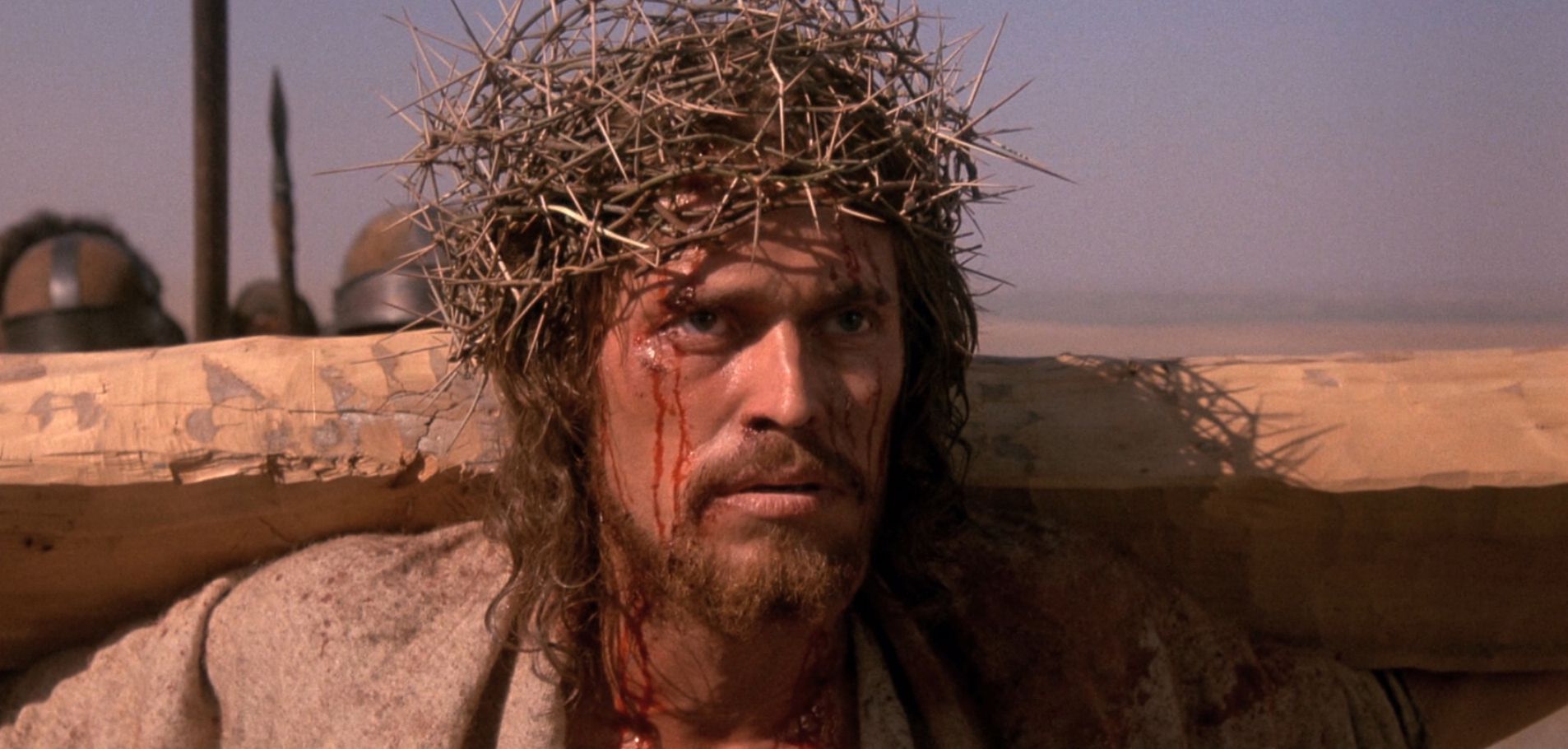Perhaps we do not have as many films as that is been made on Jesus Christ. Be it in Hollywood or British film industry or others including the Indian film industry, there are over 100 feature films that have been made on the life and times of Jesus Christ! From renowned directors and producers to relatively newcomers everyone has tried and succeeded in filming the life of Jesus from their own perspective.
One such film is The Last Temptation of Christ made in 1988 by Martin Scorsese.
The film & Religion
Christianity teaches that Jesus was both God and man. That he could be both at once is the central mystery of the Christian faith, and the subject of “The Last Temptation of Christ.” To be fully man, Jesus would have had to possess all of the weakness of man, to be prey to all of the temptations–for a man, he would have possessed God’s most troublesome gift, free will. As the son of God, he would of course have inspired the most desperate wiles of Satan, and this is a film about how he experienced temptation and conquered it.
That, in itself, makes “The Last Temptation of Christ” sound like a serious and devout film, which it is. The astonishing controversy that has raged around this film is primarily the work of fundamentalists who have their own view of Christ and are offended by a film that they feel questions his divinity. But in the father’s house are many mansions, and there is more than one way to consider the story of Christ–why else are there four Gospels? Among those who do not already have rigid views on the subject, this film is likely to inspire more serious thought on the nature of Jesus than any other ever made.
A Shocking Collaboration
That is the irony about the attempts to suppress this film; it is a sincere, thoughtful investigation of the subject, made as a collaboration between the two American filmmakers who have been personally most attracted to serious films about sin, guilt, and redemption. Martin Scorsese, the director, has made more than half of his films about battles in the souls of his characters between grace and sin.
Paul Schrader, the screenwriter, has written Scorsese’s best films (“Taxi Driver,” “Raging Bull”) and directed his own films about men torn between their beliefs and their passions (“Hardcore,” with George C. Scott as a fundamentalist whose daughter plunges into the carnal underworld, and “Mishima,” about the Japanese writer who killed himself as a demonstration of his fanatic belief in tradition).
Scorsese and Schrader have not made a film that panders to the audience–as almost all Hollywood religious epics traditionally have. They have paid Christ the compliment of taking him and his message seriously, and they have made a film that does not turn him into a garish, emasculated image from a religious postcard. Here he is flesh and blood, struggling, questioning, asking himself and his father which is the right way, and finally, after great suffering, earning the right to say, on the cross, “It is accomplished.”
The critics of this film, many of whom have not seen it, have raised a sensational hue and cry about the final passages, in which Christ on the cross, in great pain, begins to hallucinate and imagines what his life would have been like if he had been free to live as an ordinary man. In his reverie, he marries Mary Magdelene, has children, grows old. But it is clear in the film that this hallucination is sent to him by Satan, at the time of his greatest weakness, to tempt him. And in the hallucination itself, in the film’s most absorbing scene, an elderly Jesus is reproached by his aging Apostles for having abandoned his mission. Through this imaginary conversation, Jesus finds the strength to shake off his temptation and return to consciousness to accept his suffering, death, and resurrection.
During the hallucination, there is a very brief moment when he is seen making love with Magdelene. This scene is shot with such restraint and tact that it does not qualify in any way as a “sex scene,” but instead is simply an illustration of marriage and the creation of children. Those offended by the film object to the very notion that Jesus could have, or even imagine having sexual intercourse. But of course, Christianity teaches that the union of man and wife is one of the fundamental reasons God created human beings, and to imagine that the son of God, as a man, could not encompass such thoughts within his intelligence is itself a kind of insult. Was he less than the rest of us? Was he not fully man?
There is biblical precedent for such temptations. We read of the 40 days and nights during which Satan tempted Christ in the desert with visions of the joys that could be his if he renounced his father. In the film, which is clearly introduced as fiction and not as an account based on the Bible, Satan tries yet once again at the moment of Christ’s greatest weakness. One does not understand why this is offensive, especially since it is not presented in a sensational way.
Book to film
Nikos Kazantzakis wrote The Last Temptation of Christ, a highly-controversial account of the life of Jesus Christ, a subversion on what has come to be accepted as Christian truth through the Biblical Gospels. In 1988, Martin Scorsese released his equally-controversial adaptation of this novel, and the year before, Dambudzo Marechera’s life was cut tragically short.
The correlations between the Greek novelist, American filmmaker, and the Zimbabwean social critic may seem arbitrary, and mentioning Marechera in my review for The Last Temptation of Christ may seem to be the definition of grasping at straws.
However, there is a much deeper connection between Marechera’s work, particularly his masterwork, the novella The House of Hunger, and the novel and film version of The Last Temptation of Christ. Most particularly in the similar brand of postmodern thinking present in both works.
Martin Scorsese
Martin Scorsese is obviously considered one of the foremost filmmakers of his generation, know for the exceptional quality of his work and his ability to appeal to both mainstream audiences and arthouse devotees. Critics adore him, and the public worships him as a proverbial messiah of filmmaking himself (whether or not one believes this to be true is not important, as Scorsese’s status speaks directly to his enduring legacy of great filmmaking).
The Last Temptation of Christ is one of his most personal films, if not the film that speaks directly to his personal life. Personally, I found Scorsese to be the most authentic and brilliant when his films tackle the concept of faith and reflect the filmmaker’s own challenges with religion, how his strict Catholic upbringing is a constant influence on his filmmaking, with much of his work clearly displaying carnal, hedonistic existence, which we can even state were informed by Scorsese’s own foray into a life of debauchery in the 1970s as he struggled with his own personal demons.
It is upon considering the interplay between these two aspects of Scorsese’s creative and personal life that one can begin to understand why The Last Temptation of Christ is a film that polarized critics and audiences alike, as it was far too raw and visceral to be compared to more comforting and conventional representations of the trials and tribulations of Jesus Christ, and it is a film that challenges what is considered to be sacred truths.
To speak about this precise aspect of this film a bit later on, because despite being extremely important, the intentions and message of a film can only be conveyed well through the film itself, so we have to look at the tangible aspects of the film and the story before we can even begin to consider the metaphysical aspects.
Willem Dafoe
Willem Dafoe is such an effortlessly brilliant actor, one of the rare performers who are able to oscillate between memorable supporting performances, having carved out a niche position for himself as one of the most enduring character actors of his generation, as well as being able to command the screen when he is given the occasional leading role, such as in the case of The Last Temptation of Christ. Chillingly brilliant as the titular historical figure, Dafoe gives a performance that is very different from other cinematic renderings of Jesus Christ, while still keeping to the same general spirit of the character so as not to deviate from the central story too much, which would have resulted in detachment from reality.
Dafoe’s Jesus Christ is uncanny, an unsettlingly familiar version of an impenetrably famous historical figure. Dafoe does exceptionally well in conveying both facets of the character – the savior, preaching love and forgiveness and leading his proverbial flock, and as the uncertain man struggling with temptation and undergoing a crisis of faith.
It is perhaps Dafoe’s greatest leading performance, playing Jesus Christ as someone who is deeply flawed and often struggles to overcome his demons, both literally and metaphorically. Dafoe’s humanization of Jesus is almost unbearably complex, and he carries this film so well, it almost compensates for the other weaker performances around him (particularly an uncharacteristically mediocre Harvey Keitel, who seemingly sleepwalks through his performance as Judas Iscariot, consistently failing to reach the true complexities of the characters, as well as Barbara Hershey’s performance as Mary Magdalene, who is not developed as well as other characters are).
One must mention two very good performances in The Last Temptation of Christ other than Dafoe’s incredible portrayal of Jesus Christ – Harry Dean as Saul, who is later reborn as Paul, as well as David Bowie in a one-scene performance as Pontius Pilate, playing the historical figure as being far more sympathetic and complex than he is otherwise shown, and rather than being a malevolent and cruel Roman official, he shows some form of sympathy (but obviously not enough to alter the course of the narrative).
Must Read: Lesser Known Faith – “The Raelian Movement” – Out of this World!
The controversy around the film
Honestly, as a film, The Last Temptation of Christ is…unremarkable. If you remove the counterfactual narrative and the way in which this story is conveyed, it just becomes a standard and conventional Biblical narrative that is far more bleak and hopeless than the more comforting films that we have been subjected to before.
Luckily, there is far more to The Last Temptation of Christ than initially meets the eye, and I alluded to this film as a great example of postmodern filmmaking – and while it may not be absolutely over throughout the film, it still exists in a multitude of ways. This is precisely where the comparisons to the work of Dambudzo Marechera (and other postmodern writers) becomes very important, as it speaks directly to the nature of The Last Temptation of Christ.
There are a variety of postmodern elements present in this film, and while the popular Pynchonian and Warholesque conception of postmodernism advocates a more playful and almost parodic approach to the story, The Last Temptation of Christ takes a far more bleak approach.
[video_ads]
[video_ads2]
You can send your stories/happenings here:info@religionworld.in









